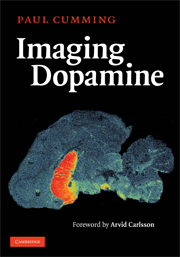Book contents
- Frontmatter
- Contents
- Foreword
- Acknowledgments
- Introduction
- 1 The life history of dopamine
- 2 Enzymology of tyrosine hydroxylase
- 3 The assay of tyrosine hydroxylase
- 4 Enzymology of aromatic amino acid decarboxylase
- 5 PET studies of DOPA utilization
- 6 Conjugation and sulfonation of dopamine and its metabolites
- 7 Dopamine synthesis and metabolism rates
- 8 MAO activity in the brain
- 9 Vesicular storage of dopamine
- 10 Dopamine release: from vesicles to behavior
- 11 The plasma membrane dopamine transporter
- 12 Dopamine receptors
- 13 Imaging dopamine D1 receptors
- 14 Imaging dopamine D2 receptors
- 15 Factors influencing D2 binding in living brain
- 16 The absolute abundance of dopamine receptors in the brain
- 17 Conclusions and perspectives
- References
- Index
- Plate section
12 - Dopamine receptors
Published online by Cambridge University Press: 04 December 2009
- Frontmatter
- Contents
- Foreword
- Acknowledgments
- Introduction
- 1 The life history of dopamine
- 2 Enzymology of tyrosine hydroxylase
- 3 The assay of tyrosine hydroxylase
- 4 Enzymology of aromatic amino acid decarboxylase
- 5 PET studies of DOPA utilization
- 6 Conjugation and sulfonation of dopamine and its metabolites
- 7 Dopamine synthesis and metabolism rates
- 8 MAO activity in the brain
- 9 Vesicular storage of dopamine
- 10 Dopamine release: from vesicles to behavior
- 11 The plasma membrane dopamine transporter
- 12 Dopamine receptors
- 13 Imaging dopamine D1 receptors
- 14 Imaging dopamine D2 receptors
- 15 Factors influencing D2 binding in living brain
- 16 The absolute abundance of dopamine receptors in the brain
- 17 Conclusions and perspectives
- References
- Index
- Plate section
Summary
Pharmacology and biochemistry
The two classes of dopamine receptors, D1 and D2, were first distinguished on the basis of classical pharmacology (Kebabian & Calne 1979). In the late 1980s, the dopamine receptor genes were cloned from rodent brain expression libraries by hybridization with the genes for homologous GTP-binding protein-linked receptors (Neve & Neve 1997). These techniques subsequently revealed a further subdivision of the two classes of dopamine receptor. The D1-like receptors consist of D1 and D5, while the D2-like receptors consist of D2, D3, and D4 receptors. In addition, alternate splicing of the D2 gene product permits the expression of a short form of the D2 receptor (D2S), and a long form with an additional 29 amino acids (D2L) at the third cytoplasmic loop (Giros et al. 1989).
Members of these two dopamine receptor classes have considerable sequence homology and broadly similar pharmacology. All of the dopamine receptors possess the 7-transmembrane domains which are characteristic of members of the large family of receptors that are coupled to GTP-binding proteins (G-proteins). Pharmacological specificity of dopamine receptors is imparted by the amino acid sequence of the agonist binding site, and transductional specificity is imparted by the nature of the intracellular G-protein binding domain. Thus, the dopamine D1-like receptors are coupled to a G-protein activating cytosolic adenylate cyclase (Gs), whereas dopamine D2-like receptors generally inhibit the activity of adenylate cyclase (Gi/Go), although other signaling pathways have also been implicated.
- Type
- Chapter
- Information
- Imaging Dopamine , pp. 160 - 166Publisher: Cambridge University PressPrint publication year: 2009



